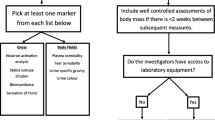Summary
The relationship between blood flow and secretion in the salt glands of conscious saltwater-adapted Pekin ducks has been investigated using intraventricular injection of radioactively labeled microspheres to measure capillary flow.
-
1.
During steady state secretion driven by continuous i.v. infusion of 1,000 milliosmolal NaCl, salt gland blood flow,\(\dot Q_w (ml \cdot \min ^{ - 1} \cdot g \cdot ^{ - 1} )\), is proportional to the rate of solute secretion,\(\dot S\), from 0 to 0.9 mOsm·min−1:
$$\dot Q_w = 28 \times \dot S + 0.7,r = 0.82$$(Fig. 3, closed circles).
-
2.
Alpha-adrenergic blockade with phenoxybenzamine, though significantly increasing myocardial blood flow by more than 50%, dose not alter either resting salt gland blood flow nor the proportionality between blood flow and secretion (Fig. 4).
-
3.
Ongoing secretion and the elevated salt gland blood flow are both decreased by atropine (Fig. 5), but the blood flows in atropine-inhibited salt glands (Fig. 3, open circles) are 3–6 fold higher than flows in ducks not receiving a salt load.
-
4.
The slope of the regression line relating salt gland blood flow and secretion rate during transient secretory responses (Fig. 6) is parallel to the steady state regression line, but shows a significant vertical offset.
-
5.
Our results indicate that salt gland blood flow is closely linked to secretion rate, with only a small component of the increased blood flow in active salt glands independent of secretory activity.
Similar content being viewed by others
References
Brownlee KA (1965) Statistical theory and methodology. Wiley, New York London Sydney, pp 349–351
Douglas DS, Neely SM (1969) The effect of dehydration on salt gland performance. Am Zool 9:1095
Fänge R, Schmidt-Nielsen K, Robinson M (1958) Control of secretion from the avian salt gland. Am J Physiol 195:321–326
Fänge R, Krog J, Reite O (1963) Blood flow in the avian salt gland studied by polarographic oxygen electrodes. Acta Physiol Scand 58:40–47
Gerstberger R, Simon-Oppermann C, Simon E (1981) Salt gland secretion in saline adapted ducks during constant salt loading alternatively applied to carotid and systemic circulation. Pflügers Arch 391 (Suppl): R24
Hales JRS (1973) Radioactive microsphere measurement of cardiac output and regional blood flow in the sheep. Pfluegers Arch 344:119–132
Hales JRS (1974) Radioactive microsphere techniques for studies of the circulation. Clin Exp Pharmacol Physiol (Suppl) 1:31–46
Hanwell A, Linzell JL, Peaker M (1971) Salt-gland secretion and blood flow in the goose. J Physiol (Lond) 213:373–387
Holtz J, Mayer E, Bassenge E (1977) Demonstration of alphaadrenergic coronary control in different layers of canine myocardium by regional myocardial sympathectomy. Pflügers Arch 372:187–194
Kaul R, Hammel HT (1979) Dehydration elevates osmotic threshold for salt gland secretion in the duck. Am J Physiol 237:R355-R359
Lundberg J (1981) Evidence for coexistence of vasoactive intestinal polypeptide (VIP) and acetylcholine in neurons of cat exocrine glands. Acta Physiol Scand (Suppl) 496:1–57
Peaker M, Linzell JL (1975) Salt glands in birds and reptiles. Cambridge University Press, Cambridge, Massachusetts (Monographs of the Physiological Society, no 32)
Schmidt-Nielsen K (1960) The salt-secreting gland of marine birds. Circulation 21:955–967
Simon E (1982) The osmoregulatory system of birds with salt glands. Comp Biochem Physiol [A] 71:547–556
Sturkie PD (1976) Avian physiology. Springer, Berlin Heidelberg New York
Thesleff S, Schmidt-Nielsen K (1962) An electrophysiological study of the salt gland of the herring gull. Am J Physiol 202:597–600
Wolfenson D, Herman A, Frei YF, Snapir N (1978) Measurement of blood flow distribution by radioactive microspheres in the laying hen (Gallus domesticus). Comp Biochem Physiol [A] 61:549–554
Author information
Authors and Affiliations
Rights and permissions
About this article
Cite this article
Kaul, R., Gerstberger, R., Meyer, J.U. et al. Salt gland blood flow in saltwater-adapted Pekin ducks: Microsphere measurement of the proportionality to secretion rate and investigation of controlling mechanisms. J Comp Physiol B 149, 457–462 (1983). https://doi.org/10.1007/BF00690003
Accepted:
Issue Date:
DOI: https://doi.org/10.1007/BF00690003




